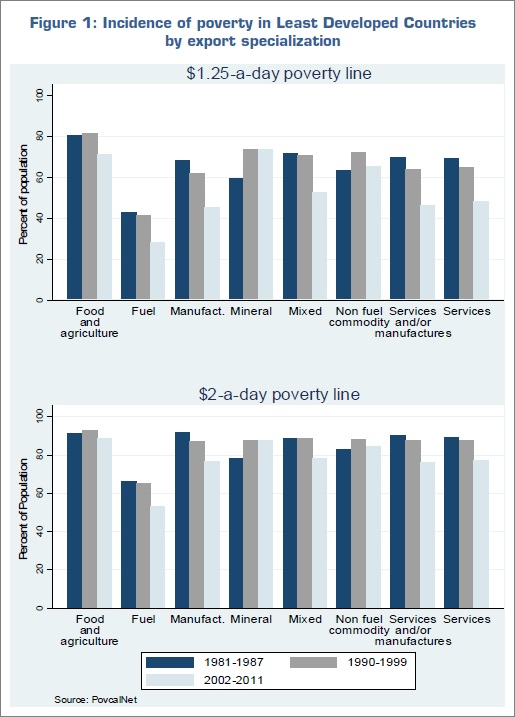News
Estimating the impact of trade specialization and trade policy on poverty in developing countries

This paper investigates the impact of trade specialization on poverty in developing countries. The findings show that trade specialization reduces poverty but only under specific patterns and policy conditions. In all developing countries manufacturing exports contribute to poverty reduction, whereas for low income countries the share of agriculture exports has additional poverty reduction effects.
Agriculture constitutes a key sector in most low-income economies and is generally the primary source of income in rural areas, both directly by crop production and indirectly through on-farm and off-farm employment in agriculture-related industries. Moreover, for low income countries, moving out from commodities into agriculture would lead to a poverty-reducing scenario, as the agriculture sector has more potential spillover effects and backward linkages than enclave type of commodities exports.
Poverty is multi-dimensional and thus cannot be treated in a simplistic way. The benefits from trade are not automatic and policies are needed as a complement, to address both the welfare impacts and the factors that affect a country's trade specialization and productive capacity. As the UN and development partners move forward with the post-2015 global development agenda, the right policy approach is needed to strengthen productive sectors and diversify export profiles to accomplish the sustainable development goals (SDGs) in general, and in particular the goals related to improved livelihoods, jobs and productive capacity, trade and enabling the global trading environment for sustained and inclusive development. Further research should focus on understanding the distributional impacts of trade and trade policy, looking at broader measures of trade policy, notably Non-tariff barriers.
Introduction
Trade can play an important role in the development process; however the linkages can be direct or indirect and the benefits are not necessarily instantaneous. International trade can impact welfare directly, in a number of ways, via changes in relative factor and good prices, factor movements, and the nature of technological change and knowledge spillover. Trade policy has the potential to generate benefits in terms of both resource allocation and economic growth. But trade policy is not neutral and trade liberalization is unlikely to produce widespread beneficial results for all countries.
In the short run, trade liberalisation can put great stress on certain actors in the economy, and in the long run open regimes may leave some behind in poverty. Many studies suggest that globalization has been associated with rising inequality and that the poor do not always share in the gains from trade. The links between trade, trade policy, and poverty depend on a range of factors including a country’s domestic policies and institutional capacities. For instance, Chang et al (2009) observe that although trade openness appears to, on average, be beneficial for economic growth the effect varies considerably across countries. Importantly, complementary reforms can boost the growth effects expected from pursuing a more open trade regime.
The literature on trade, trade policy and poverty is voluminous but studies focusing on low income countries are scarce. This paper aims to contribute by analyzing the link between trade specialization and poverty with special focus on low income and least developed countries. The paper also analyses the relative impact of trade policy measures on poverty dynamics. Looking at poverty incidence by specialization patterns, for example, LDCs that specialize in food and agriculture have higher poverty ratios than countries specializing in manufactures (Figure 1). Fuel exporting LDCs have lower poverty incidence than their peers, regardless of the chosen poverty line or period of time, mostly due to the income value of their exports and lower financial constraints.2 Moreover, there is evidence that the poorest and most vulnerable countries face more challenges in adjusting to openness in comparison to countries that have achieved a relatively more sophisticated level of industrialization.


